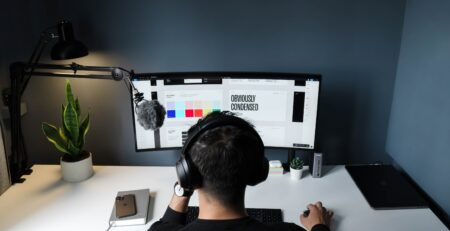Creatives, Feeling Burned Out? These 7 Stress Relief Hacks Actually Work!
In the fast-paced, ever-changing creative industries, burnout has become a common plight among professionals. Whether you’re a graphic designer, a writer, or a digital artist, the pressure to consistently produce innovative work can take its toll. Burnout not only hinders creativity but also affects overall well-being. However, the right stress relief techniques can serve as a lifeline. In this feature, we explore seven hacks that have proven effective for creatives struggling with burnout, incorporating practical advice that can be seamlessly adopted into your routine to revitalize your creative energies.
The onset of burnout in creatives is often subtle, manifesting initially as minor fatigue or lack of enthusiasm for projects that once sparked excitement. Over time, these symptoms can intensify, leading to a significant drop in productivity and creativity. It’s crucial for creatives to recognize these early signs and implement strategies to combat them effectively.
Tailored specifically for individuals in creative fields, the stress relief techniques we discuss here are designed not just for temporary relief but for long-term sustainability. These methods focus on restoring mental clarity and fostering an environment where creativity can flourish unhindered by stress and fatigue. Understanding that each creative’s journey and challenges are unique, these hacks offer a variety of approaches to suit different preferences and situations.
From revamping your daily routine with mindfulness exercises to redefining your workspace to enhance creativity, these stress relief hacks are backed by both psychological research and anecdotal evidence from successful creatives who have walked this path before. Whether you are facing deadlines, client demands, or creative blocks, integrating these strategies into your life can pave the way for renewed creative vigor and resilience.
Embrace these insights as a guide to not only manage stress but also to reclaim your passion for creativity. Let’s delve into the effective stress relief strategies that can help you maintain your creative edge while ensuring your mental and emotional well-being remains intact.
The Most Asked Questions on Creative Burnout and Stress Relief
- What are the common signs of burnout specific to creative professionals?
- How can regular exercise influence stress levels and creativity in my daily professional life?
- What role does a well-organized workspace play in managing creative burnout?
- Can mindfulness and meditation really help creatives manage stress?
- Are there any quick stress relief techniques to use during the workday for immediate effect?
Common Signs of Burnout in Creative Professionals
Burnout among creatives can manifest in various ways, significantly impacting both personal and professional life. Recognizing these signs is the first step toward effective management and recovery. Common symptoms include chronic fatigue, disillusionment with one’s own work, irritability, difficulty in starting new projects, and a noticeable decline in productivity.
The relentless pursuit of perfection, a hallmark of many creative professions, can exacerbate feelings of inadequacy and frustration. This often leads to prolonged periods of stress, eventually culminating in burnout. It’s essential for creatives to acknowledge their limits and seek strategies to recharge.
Additional indicators include a lack of motivation, changes in appetite or sleep patterns, withdrawal from social interactions, and a reduction in the ability to execute creative tasks. These symptoms not only diminish work quality but also affect overall life satisfaction. Addressing these issues promptly can prevent them from progressing into more severe mental health concerns.
For practical guidance on stepping back and reevaluating your professional strategies to prevent burnout, exploring avenues like restructuring your professional profile can offer a new perspective and renewed motivation.
Maintaining an awareness of these signs and taking preemptive steps to manage stress is crucial. Incorporating regular breaks, seeking feedback, and setting realistic deadlines are practical measures that can significantly alleviate pressure. For more targeted approaches, professionals might consider consultations with coaches who specialize in creative industries.
For a deeper understanding of burnout and its effects on mental health, resources such as the National Institute of Mental Health provide valuable insights and research findings. Additionally, engaging with community support groups online can offer solace and practical advice from peers encountering similar challenges.
Ultimately, acknowledging that burnout is a common and treatable condition can empower creatives to seek the help they need. By recognizing the signs early and responding with effective strategies, it is possible to sustain creativity and enthusiasm in your professional life.

Influence of Regular Exercise on Stress and Creativity
Engaging in regular physical activity is widely recognized for its extensive health benefits, including improved mood, enhanced energy levels, and reduced risk of chronic diseases. For creatives, the benefits extend into enhanced creativity and reduced stress levels, making exercise a crucial component of a balanced lifestyle.
Exercise stimulates the release of endorphins, often referred to as ‘feel-good’ hormones, which can create feelings of euphoria and general well-being. This biochemical boost can significantly alleviate the symptoms of stress and anxiety often associated with creative professions.
In addition to boosting mood, regular exercise can enhance cognitive function, leading to better problem-solving skills and increased mental clarity. These enhancements are invaluable for creatives, who rely heavily on their cognitive abilities to generate new ideas and solutions.
Physical activity also promotes better sleep patterns and helps regulate circadian rhythms, which can be particularly beneficial for creatives who often work irregular hours. A good night’s sleep improves overall brain function and can be a critical factor in overcoming creative blocks and maintaining productivity.
Implementing a routine exercise regimen need not require significant time commitments or intense physical exertion. Activities like yoga, stretching, or short walks can effectively incorporate into a daily routine, offering immediate benefits without overwhelming your schedule.
For those looking to delve deeper into the relationship between exercise and mental health, Mayo Clinic’s research provides extensive insights into how physical activity benefits psychological well-being.
Professional advice on integrating exercise into your routine can also be crucial. Many creative professionals find that speaking with a fitness coach who understands the unique demands of creative work can tailor an exercise plan that enhances both their physical and mental health.
For further exploration on optimizing your workspace for health benefits, including integrating standing desks or scheduling regular movement breaks, icreatives offers insights on creating a workspace that supports both health and productivity.
Incorporating exercise into your daily routine can seem daunting, yet the benefits it provides in managing stress and enhancing creativity are undeniable. By setting realistic goals and gradually increasing the intensity and duration of exercise, creatives can enjoy these benefits without feeling overwhelmed.
The Role of a Well-Organized Workspace in Managing Creative Burnout
A well-organized workspace can play a pivotal role in managing stress and preventing burnout for creative professionals. The physical environment where one works significantly impacts productivity, creativity, and general well-being. A cluttered or uncomfortable workspace can contribute to mental clutter and increase stress levels, thereby exacerbating feelings of burnout.
The first step in optimizing your workspace is decluttering. Removing unnecessary items and organizing essential tools and materials can help minimize distractions and enhance focus. This creates a conducive environment for creativity, where ideas can flow more freely.
Ergonomics also plays a critical role in workspace organization. Investing in a good quality chair, ensuring that the computer monitor is at eye level, and keeping essential tools within easy reach can reduce physical strain, which, in turn, helps maintain higher energy levels throughout the day.
Lighting is another crucial element—not only for performing specific tasks but also for maintaining general well-being. Natural light is ideal, but if this isn’t possible, ensuring that the workspace is well-lit with soft, adequate lighting can prevent eye strain and boost mood.
Incorporating elements of nature, such as plants, can improve air quality and add a calming effect to the workspace environment. Studies have shown that having plants in the workplace can reduce stress and enhance productivity.
An often-overlooked aspect of workspace organization is the importance of personalization. Adding personal touches such as artwork, photos, or other inspirational items can make the space feel more inviting and stimulating.
For those seeking specific ideas on enhancing their workspace, icreatives’ blog on attracting and retaining talent offers valuable tips that can be adapted to personal workspace design.
Whether you’re dealing with deadline pressures, client demands, or your own aspirations to excel, integrating these hacks into your everyday life can make a significant difference. Let’s dive into these life-enhancing tactics and how they can help you keep your creative spark alive.
1. Structured Daily Routines
Establish a daily routine that includes designated times for work and relaxation. A consistent schedule helps manage time effectively, reducing the risk of work-related stress. Include regular breaks and set specific times for checking emails and social media to prevent these activities from consuming your creative time.
2. Physical Activity
Incorporate short sessions of physical activity into your day. Even a 15-minute walk, yoga session, or a quick workout can elevate endorphins, improving mood and clearing your mind. This boost in energy levels can significantly benefit your creative output.
3. Mindfulness and Meditation
Practicing mindfulness or engaging in meditation can dramatically reduce stress. Allocate a few minutes each day to meditate, helping you gain better focus and keep your thoughts organized. Apps like Headspace provide guided meditations specifically designed for workplace stress.
4. Creative Breaks
Take breaks specifically to indulge in non-work-related creative activities. Whether it’s sketching, playing an instrument, or writing, engaging in creativity that’s not linked to work can act as a mental reset button, refreshing your mind and spirit.
5. Optimal Workspace Setup
Organize your workspace to reduce clutter and boost inspiration. Invest in comfortable furniture, proper lighting, and aesthetically pleasing decor. The physical environment has a profound impact on your psychological well-being and creative performance.
6. Digital Detox
Limit your exposure to digital screens outside of work. Excessive screen time can lead to digital eye strain and mental fatigue. Periods of digital detox help your brain recover and reduce stress, giving you clearer thoughts and enhanced focus when you return to work.
7. Healthy Social Interactions
Maintain a supportive social network. Interacting with fellow creatives can provide emotional support, fresh ideas, and a different perspective. Networking doesn’t just have to be about career opportunities; it’s also about building relationships that provide support and inspiration.
Each of these strategies is aimed at helping professionals in the creative field manage their stress effectively while nourishing their creativity. By integrating these hacks into your routine, you not only enhance your professional productivity but also improve your overall quality of life.
By adopting a mindful approach to work and personal care, you can ensure that your creativity remains a source of joy and fulfillment, rather than stress and exhaustion. Refresh your approach, rejuvenate your mind, and revitalize your creative work with these proven strategies.
Conclusion
The challenges that come with creative professions are as unique as the work produced by these talented individuals. While the pressures of delivering consistent, innovative content can lead to burnout, the right strategies and tools can empower you to manage stress effectively and maintain your creative edge. From structuring your daily routine to incorporating mindfulness and ensuring a supportive workspace, each stress relief hack discussed here offers a pathway to a healthier, more satisfying professional life.
Remember, taking care of your mental and emotional health is as crucial as refining your craft. By adopting these seven stress relief hacks, you’re not just preventing burnout; you’re also investing in your long-term creative potential. So, take a moment to assess your current stress levels, experiment with these techniques, and find what best helps you recharge and inspire. Here’s to a more balanced, productive, and creatively fulfilling career!
In today’s competitive market, finding the right creative and marketing expert can be a challenge. But with icreatives, you’re in experienced hands. With 37 years in staffing and a track record of matching more than 10,000 employees to over 1,000 companies worldwide, we know how to connect you with the best. Plus, you only pay if you hire—there’s no risk, only results. Ready to find your perfect creative or marketing expert? HIRE WITH ICREATIVES today!












